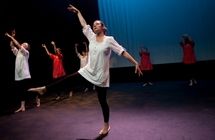
On a wet, dark October evening my spirit was warmed when I visited the Centre for Contemporary Arts (CCA) in Glasgow for an event that was part of the International Human Rights Documentary Film Festival.
The evening combined the film Forbidden Sun Dance, organised by Dance House, with a performance by Maryhill Integration Network Music and Theatre project entitled Back and Forth. A perfect combination, each enriching the other.
Forbidden Sun Dance is a film about Aram Bayat, a choreographer and teacher of Persian folk dance living in exile in Montreal, Canada.
After the 1979 revolution and the establishment of the Islamic Republic of Iran, along with other restricted areas of art, dancing was banned. Many of the artists, Aram Bayat included, who helped shape the revolution resisted the censorship and rules of the Islamic regime. Some of these artists were executed, others put in prison or were forced into exile.
Dance – a natural form of communication
During the film Aram talked passionately about the immediacy of dance, how it is a natural form of communication for people, instinctive rather than taught. It allows for a freedom of expression that overcomes language barriers and unites people. I can only agree with her sentiment, especially after watching Back and Forth, the dance piece that followed. The energy and integrity of the refugees, people seeking asylum and Glaswegians who took part further illustrated the poignancy of Aram’s words.
I was moved as dancers from the local community, with little training, connected with the audience. Even though no words were spoken, I fully understood the pain, sorrow and joy of what they were conveying.
Express yourself – get involved in the arts!
We support a variety of arts and cultural events, groups, performances, screenings, exhibitions and workshops, which run throughout the year. If you’d like to get involved, find out more on our website.
